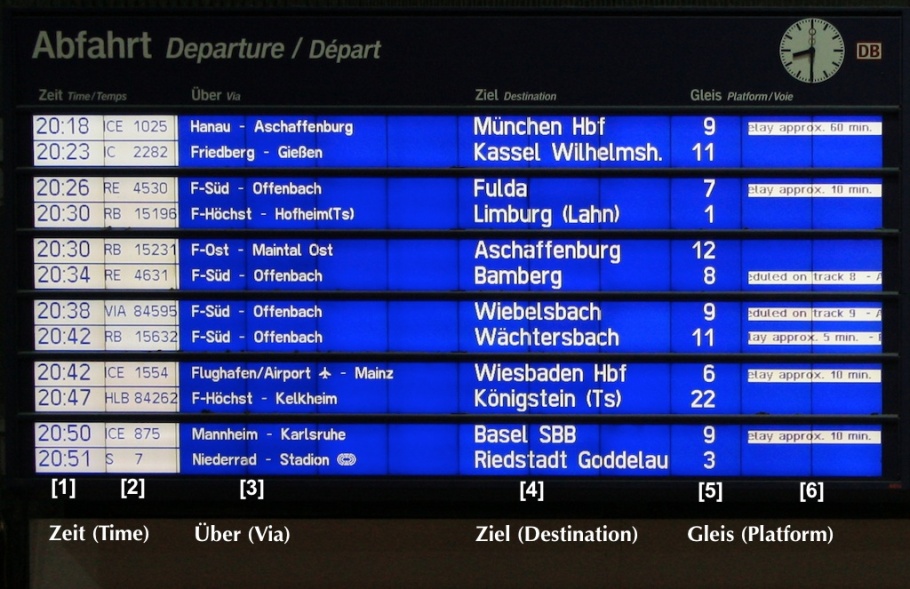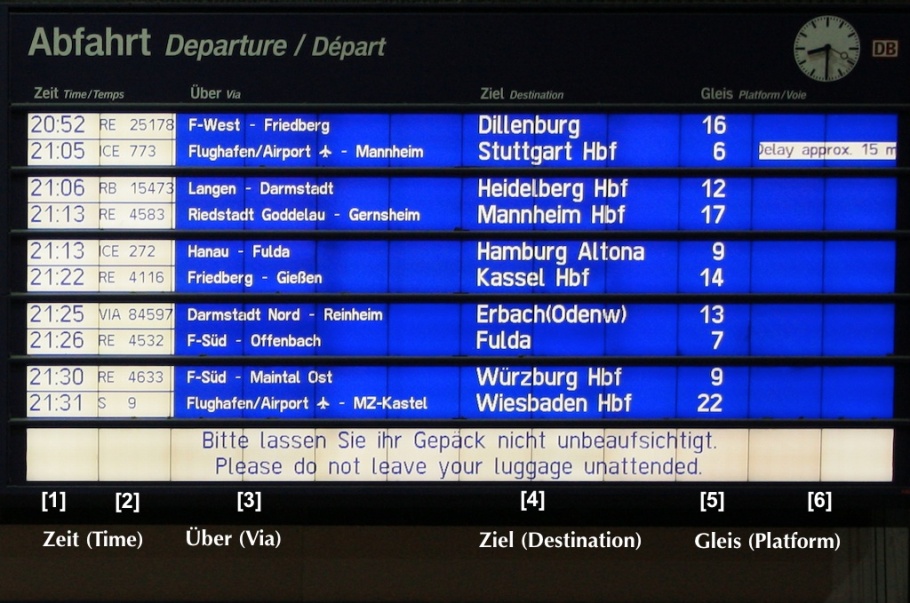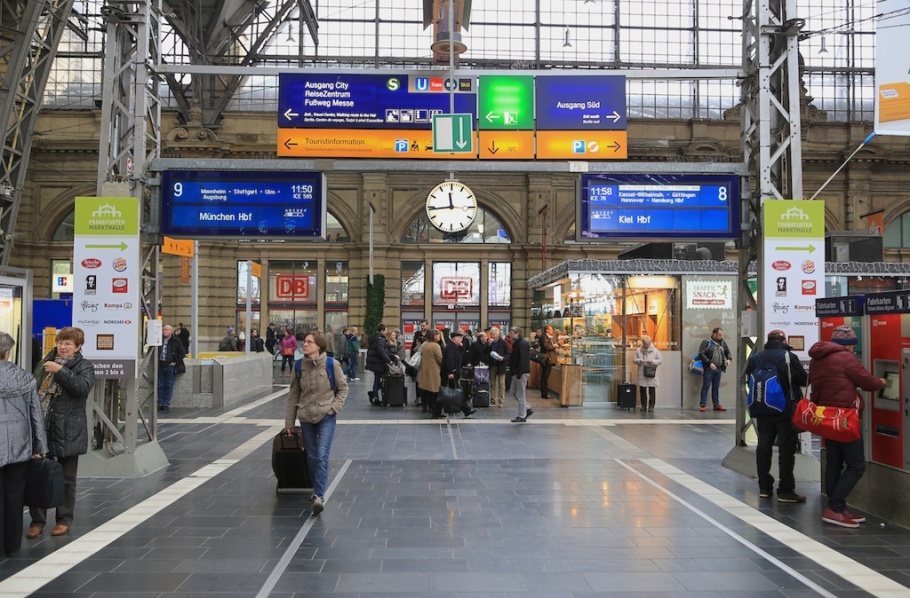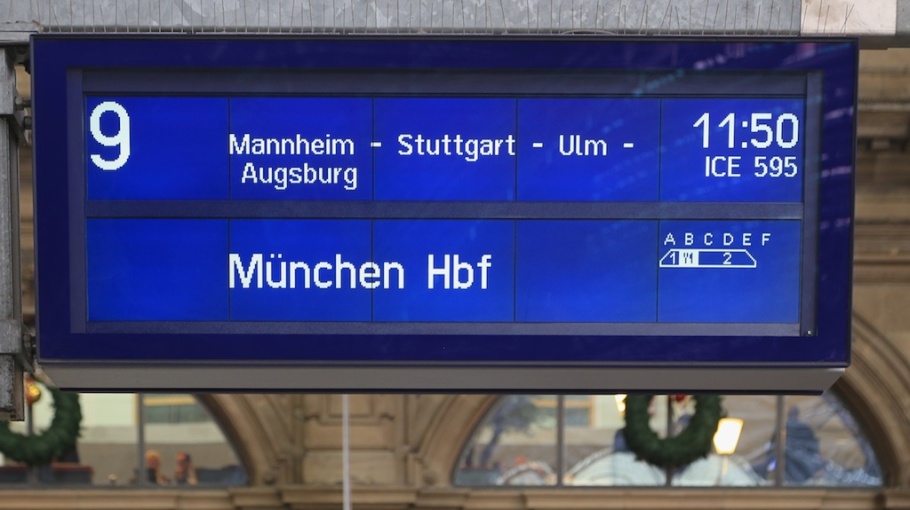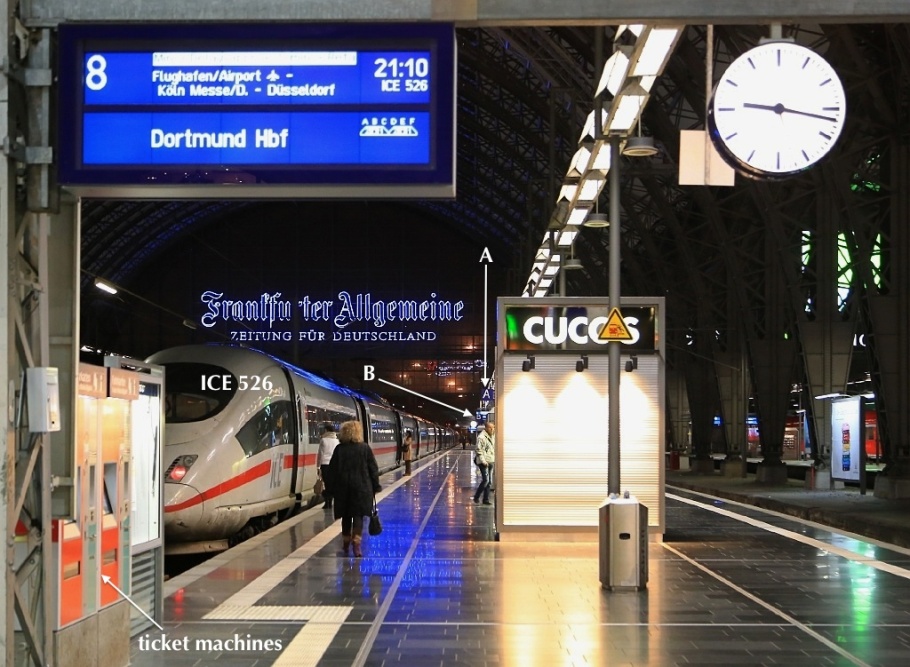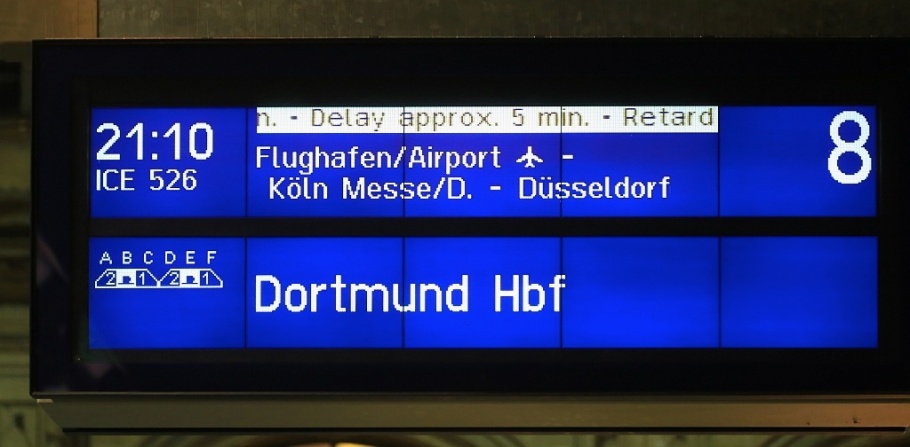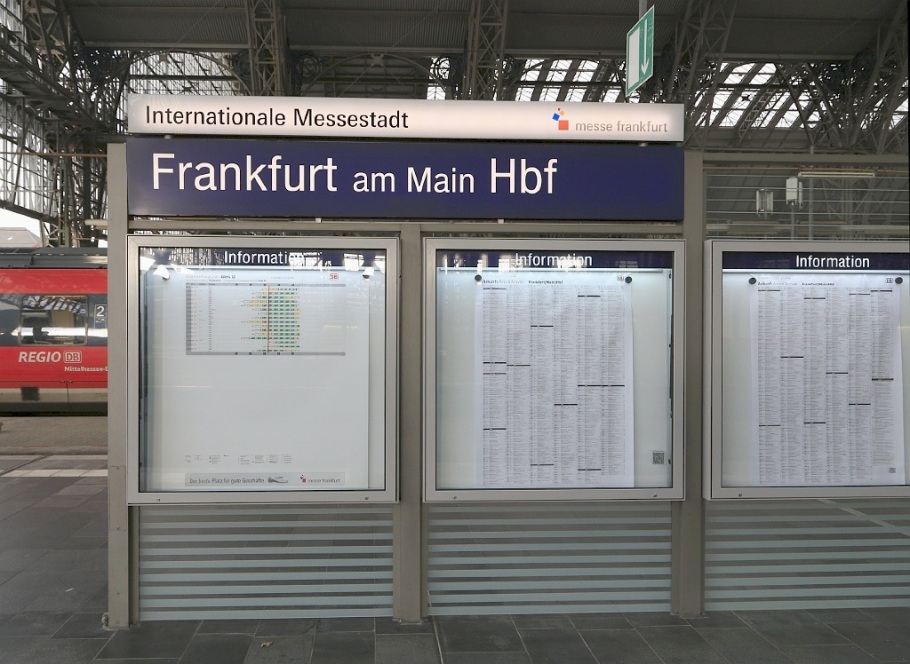By
fotoeins on 16 February 2015
The following is a short visual descriptive guide to signage at German rail stations to help get you on your way. Examples below are taken from Frankfurt am Main Hauptbahnhof (central or main train station). The general descriptions should apply everywhere throughout the country.
Where’s my train? The departures board (Abfahrtstafel)
In most medium- to large-sized German cities, every Hauptbahnhof (Hbf) or central train station will have a large departures board in the central hall and/or over the information booth. The photo above shows the departures board in the middle of Frankfurt’s station with the message:
“Herzlich Willkommen in Frankfurt am Main Hbf – Welcome to Frankfurt am Main Central Station”.
Information on the departures board appears as white block lettering on a dark blue background. From left to right in the photo below, there are six primary columns of information:
- Departure time (Zeit)
- Train number
- Intermediate stops (Über)
- Final destination for train (Ziel)
- Platform number (Gleis)
- Additional information
The departures board above shows Regional Bahn train RB 15231 leaving at 830pm (2030h) for Aschaffenburg from platform 12, with stops at F-Ost (Frankfurt Ost) and Maintal Ost. There’s no additional information which means the train is scheduled to depart on time.
The other departures board shows InterCity Express ICE 773 leaving for Stuttgart from platform 6 at 905pm (2105h), with stops at Frankfurt Airport (Flughafen) and the city of Mannheim. There’s an additional note that the train is about 15 minutes late, putting the departure time to about 920pm.
What’s my train? Destination signage (Zugzielanzeiger), by day
Above every platform are overhead digital signs to confirm what travelers might see on the central board. The signs also appear as white lettering on a blue background. Occasionally, two trains will share the same platform which the signage will also reflect. Highlighted sections will correspond to the appropriate train; take note that you board the correct train.
The following are examples of daytime departures from platforms 8 and 9.
From platform 8, InterCity Express train ICE 76 leaves at 1158am for Kiel Hauptbahnhof (Hbf), with stops in Kassel-Wilhelmshöhe, Göttingen, Hannover, and Hamburg Hauptbahnhof. There’s a five-minute delay, pushing the departure time to about 1203pm.
Every platform is “divided” into sections, which are also labeled with overhead signage (A, B, C, etc.) indicating where you are along the platform. The electronic sign also shows how the train itself is divided. 1st-class cars are in section A, the dining car is in section B, and the rest of the train consists of 2nd-class cars from sections C through E.
From platform 9, InterCity Express train ICE 595 leaves at 1150am for München (Munich) Hauptbahnhof, with stops in Mannheim, Stuttgart, Ulm, and Augsburg. The sign above shows that first-class cars are along section A, the dining car along section B, and the rest of the train consists of second-class cars from sections C through E.
What’s my train? Destination signage (Zugzielanzeiger), at night
The following is an example of a nighttime departure from platform 8.
It’s 917pm, but the 910pm train from platform 8 hasn’t departed. I’ve labeled the train ICE 526, overhead signage indicating platform sections ‘A’ and ‘B’, as well as the familiar red and blue Deutsche Bahn ticket machines. It’s preferable (and often cheaper) to purchase a ticket before boarding the train; the ticket machines have multilingual options and sell tickets for regional and long-distance trains.
In fact, ICE 526 heading to Dortmund Hauptbahnhof is approximately 5 minutes late, which means this train is about to leave at any moment. The train makes stops at Flughafen Frankfurt am Main Airport and in Köln (Cologne) at Messe/Deutz station. Note that 2nd-class cars are located along sections A and D, dining cars at sections B and E, and 1st-class cars at sections C and F
Where’s my coach? Coach sequence signage (Wagenreihungsplan)
If you’ve purchased a ticket with assigned seating in a specific coach or car, you have to locate the correct coach for the train. Every station platform has a large sign “Wagenreihungsplan” or “Wagenstandsanzeiger”, describing how coaches are sequenced for each train leaving from that platform.
The labeled columns shown left to right in the photo below are for trains leaving from platform 12:
- Departure time (Zeit)
- Train (Zug)
- Information, notes (Hinweis)
- Direction, destination (Richtung, Ziel)
- Coach sequence (Wagenreihung)
- Signage location, “where am I?” (Standort)
Coaches in green are 2nd-class cars, coaches in yellow are 1st-class cars, and coaches in red are dining cars. Every coach is labeled by a number. The short black arrow next to the train engine indicates the direction leaving the station. In other words, coaches next to platform sections C, D, E are at the “front” of the departing train at Frankfurt station.
Where is this “Wagenreihungsplan” signage located? (“Where am I?”) The red dot and red vertical line indicate the sign’s location between platform sections B and C.
For example, train IC2297 leaves platform 12 at 820pm (2020h) for Stuttgart. However, there are three rows for the same train number, indicating different coach sequences for different days of the week. The train indicated by the white asterisk or star is assigned for departures Monday to Wednesday (Montag bis Mittwoch) inclusive. Where the red vertical line intersects this row shows that the “Wagenreihungsplan” signage shown here would be located opposite 2nd-class coach number 6.
At times, you may hear a public announcement and/or see a notice on the overhead track signage about changes to the coach sequence: namely,
• “umgekehrte Wagenreihung”: coach sequence is completely reversed.
• “abweichende Wagenreihung”: coach sequence is different than scheduled.
Schedules for departures & arrivals
You’ll also see printed-paper displays for arrivals and departures. Arrivals are always displayed as black text on a light grey background, and departures are always displayed as black text on a yellow background. The lists of arriving and departing trains are ordered by the time of day.
The Deutsche Bahn website also provides an updated to-the-minute online version of an arrivals and departures board
here in German or
here in English. Up-to-date information is given two hours in advance from your present time, including information about the assigned platform for arriving/departing trains and whether trains are early or late. Just like the printed-paper displays, arrivals and departures are shown on light grey and yellow backgrounds, respectively.
Questions or comments about trains in Germany? Please leave them below!
I made the photos above at Frankfurt am Main Hauptbahnhof on 10 October 2009 and 20 November 2014. This post appears on Fotoeins Fotopress at fotoeins.com as
http://wp.me/p1BIdT-6k7.










